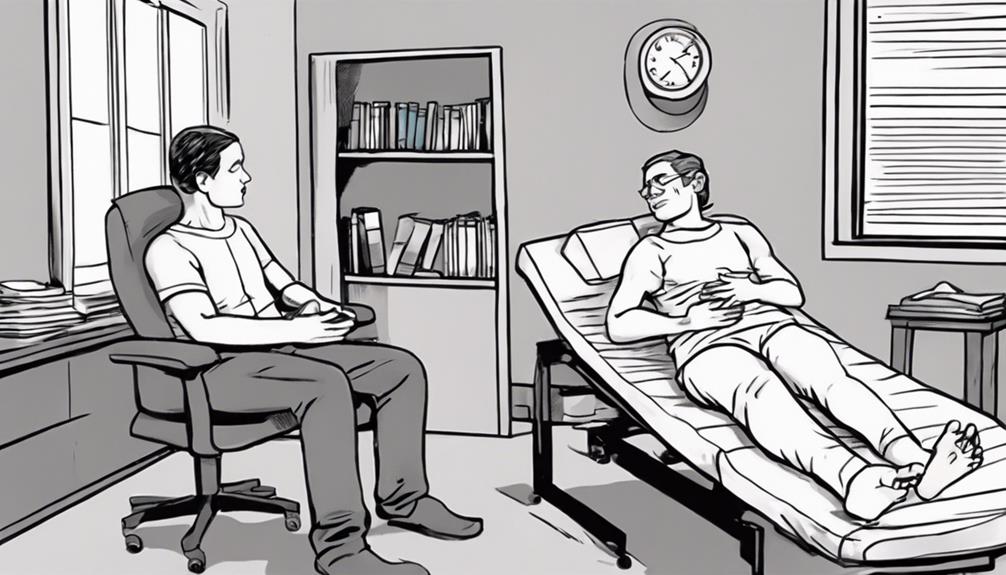Discover how Somatic Experiencing Therapy supports trauma healing and stress management through body awareness, coping skills, and preventing re-traumatization. This therapy employs a range of methods such as breathwork, hypnosis, and EMDR to improve emotional regulation and self-awareness. Somatic Therapy is beneficial for individuals dealing with trauma, anxiety, depression, or persistent pain, assisting in emotional release and stress reduction. With the help of a skilled therapist, you can cultivate somatic awareness, address underlying issues, and effectively interpret body cues. Learn more about how this therapy can empower you to explore further into healing and well-being.
Key Takeaways
- Somatic Experiencing Therapy uses body awareness for trauma healing.
- Techniques like EMDR and Brainspotting are common in somatic therapy.
- Somatic therapy focuses on mind-body connection for healing.
- Breathwork, hypnosis, and acupressure are somatic therapy practices.
- Somatic therapy helps release trapped emotions and improve mental health.
Somatic Experiencing Therapy Explained

Explore how Somatic Experiencing Therapy provides a unique approach to healing trauma through body awareness. This therapeutic approach focuses on helping individuals track bodily sensations, regulate stress responses, and develop coping skills without directly re-experiencing traumatic events.
By grounding clients in the present moment and encouraging them to explore their internal bodily experiences, Somatic Experiencing Therapy aims to release stored traumatic energy gradually.
Through somatic interventions like pendulation and resourcing, this therapy helps trauma survivors build a sense of safety and empowerment. By paying attention to interoceptive, proprioceptive, and kinesthetic sensations, individuals can learn to navigate overwhelming emotions and distressing memories in a more manageable way.
Somatic Experiencing Therapy equips clients with tools to regulate their nervous systems and cultivate resilience in the face of adversity. By fostering a deeper connection between mind and body, this approach offers a holistic path to healing trauma.
Somatic Therapy Techniques and Practices

To understand the practical application of somatic therapy techniques and practices, it's essential to explore how these methods facilitate healing through the body-mind connection. Somatic therapy encompasses various techniques and practices that aim to enhance body awareness, address bodily sensations, and process trauma memories effectively.
Here are some key elements of somatic therapy techniques and practices:
- Somatic therapy techniques encompass breathwork, hypnosis, and acupressure to release trapped emotions in the body.
- Practices like titration, pendulation, and resourcing assist individuals in developing awareness of bodily sensations.
- Specific techniques such as EMDR and Brainspotting are utilized to boost body awareness and diminish the vividness of trauma memories.
- Somatic therapists prioritize helping individuals feel safe in their bodies while managing their thoughts and emotions.
Body awareness, movement, and mindfulness practices play a vital role in the effectiveness of somatic therapy techniques and practices.
Effectiveness of Somatic Therapy

Somatic therapy demonstrates significant effectiveness in treating trauma survivors and various mental health conditions. Techniques like Eye Movement Desensitization and Reprocessing (EMDR) and somatic awareness practices play an essential role in addressing traumatic experiences and PTSD, leading to improved mental health outcomes. Scientific research supports the use of somatic therapy for trauma treatment, highlighting its effectiveness in releasing trapped emotions and enhancing overall well-being.
To provide a clearer picture, let's look at a comparison table showcasing the effectiveness of somatic therapy in addressing trauma and mental health conditions:
| Therapy Technique | Effectiveness in Trauma Treatment |
|---|---|
| EMDR | Proven efficacy in releasing trapped emotions and addressing PTSD symptoms. |
| Somatic Awareness | Enhances mind-body connection, facilitating the processing of traumatic experiences. |
| Hakomi Method | Reduces stress, increases awareness, and addresses compulsive behaviors related to trauma. |
Who May Benefit From Somatic Therapy

You may benefit from somatic therapy if you're struggling with trauma, anxiety, depression, or chronic pain.
Increasing your body awareness, managing emotions, and addressing past experiences stored in your body are potential benefits of somatic therapy.
If you experience stress, dissociation, or somatic symptoms like tension, headaches, or digestive issues, somatic therapy could offer relief.
Targeted Therapy Recipients
Individuals who've experienced trauma, stress, anxiety, or depression may benefit from somatic therapy. Somatic therapy is particularly helpful for trauma survivors, as well as those dealing with PTSD. It can offer relief from stress and help alleviate both emotional and physical symptoms.
Here are a few targeted therapy recipients who may find somatic therapy beneficial:
- People Seeking Stress Relief: Somatic therapy can be effective for individuals looking to manage and reduce stress levels.
- Those Dealing with Anxiety and Depression: Somatic therapy techniques can assist in coping with anxiety and depression symptoms.
- Individuals with Chronic Pain: Somatic therapy may provide relief for those experiencing chronic pain conditions.
- Dissociators or Individuals Feeling Disconnected: Somatic therapy can aid those feeling disconnected from their bodies or struggling with dissociation.
Beneficial Client Profiles
Clients with a history of trauma, chronic stress, or PTSD may benefit greatly from somatic therapy. Somatic therapy can help individuals experiencing traumatic stress by addressing physical sensations and enhancing body awareness. This form of therapy focuses on the mind-body connection, allowing clients to release trapped emotions stored in the body.
If you struggle with emotional regulation, somatic therapy can provide techniques to manage and express emotions effectively. Additionally, if you find it challenging to connect with your body or experience physical symptoms like chronic pain, tension, or digestive issues, somatic therapy may offer relief.
Applicable User Demographics
For those considering somatic therapy, understanding the applicable user demographics can provide insight into who may benefit from this form of therapy. Somatic therapy can be particularly beneficial for individuals dealing with traumatic memories, chronic pain, and emotional distress. However, it mightn't be suitable for pregnant individuals, those with serious medical conditions, or frequent dissociators due to the nature of certain somatic therapy practices.
Recent research has shown promising results in using somatic therapy, such as Eye Movement Desensitization and Reprocessing (EMDR), for trauma and PTSD treatment. Additionally, techniques like asking the three Ws (What's going on, Where's it coming from, What do I need) can help somatic therapists assess body signals accurately and tailor therapy to individual needs.
Remember that somatic therapy is a versatile approach that can offer relief to a wide range of individuals experiencing various physical and emotional challenges.
Considerations for Somatic Therapy

Consider consulting with a mental health professional before starting somatic therapy to confirm it aligns with your individual needs and circumstances. This step is vital, especially if you have serious medical conditions or if you're pregnant, as certain somatic therapy practices like EMDR may not be suitable for you.
Somatic therapy has shown to be beneficial for individuals seeking relief from trauma and PTSD, with techniques like EMDR demonstrating positive effects on mental health. When exploring somatic therapy options, it's advisable to seek a somatic therapist specializing in areas such as PTSD, trauma, or mindfulness exercises for more tailored treatment.
Understanding and interpreting body signals is also essential in somatic therapy. Asking questions like What's going on, Where's it coming from, and What do I need, can help assess these signals and customize the somatic therapy approach to better suit your needs.
Somatic Psychotherapy Overview

To understand Somatic Psychotherapy, it's vital to recognize its focus on the mind-body connection and the storage of memories and emotions on a cellular level. In this form of therapy, traumatic memories and emotions are believed to be stored not only in the mind but also within the body itself.
Here are some key aspects of Somatic Psychotherapy:
- Body Awareness: Somatic Therapy emphasizes the importance of being aware of physical sensations and how they relate to emotional experiences.
- Healing and Recovery: By addressing the mind-body connection, Somatic Psychotherapy aims to promote healing and recovery from past traumas.
- Emotions: This therapy modality acknowledges the impact that suppressed emotions can have on both physical and mental well-being.
- Mind-Body Connection: Understanding how the body and mind influence each other is vital in Somatic Psychotherapy for thorough healing.
Benefits of Somatic Interventions

Somatic interventions provide you with effective ways to release stored emotions and alleviate physical discomfort. By engaging in somatic therapy, you can experience a range of benefits such as improved emotional regulation, enhanced self-awareness, and relief from muscle tension. These interventions are particularly beneficial for trauma recovery, chronic anxiety, and stress relief.
Somatic therapy techniques not only help you address surface-level symptoms but also allow you to access deeper root issues stored in your body, leading to profound healing on a cellular level. Moreover, somatic interventions can assist you in draining emotions of their power, relieving pain, reducing stress, and improving disrupted sleep patterns.
Accessing Root Issues Through Somatic Therapy

By delving into somatic therapy, you can effectively access and confront the hidden beliefs stored within your body. Somatic therapy provides a safe space for individuals to explore unresolved emotional issues stemming from past traumas. Here are some key aspects of accessing root issues through somatic therapy:
- Renegotiation of Past Events:
Somatic therapy allows for the renegotiation of past events at a body-based level, helping you work through traumatic memories.
- Sensations in the Body:
Through somatic techniques, you can tune into bodily sensations to uncover and process deeply-rooted beliefs that may be impacting your mental health.
- Setting Boundaries:
Establishing boundaries within the therapeutic process can help you feel protected and steady as you confront challenging emotions.
- Support from Somatic Therapist:
A skilled somatic therapist can guide you through techniques like titration and pendulation to pace trauma processing appropriately.
Developing Somatic Awareness

To develop somatic awareness, start by noticing how your body reacts to different situations and stimuli.
Pay attention to bodily sensations that may indicate areas of tension or discomfort.
Body Sensations Awareness
Developing somatic awareness involves actively tuning into your body's sensations to recognize areas of tension and constriction. By honing in on your bodily sensations, you can deepen your understanding of how your body responds to different stimuli.
Here are some key aspects of body sensations awareness in somatic therapy:
- Identifying Body Sensations: Paying attention to the physical sensations in your body helps in pinpointing areas of discomfort or tension.
- Exploring Somatic Awareness: Delving into somatic awareness allows for a more profound connection with your body and its signals.
- Utilizing Body-Focused Techniques: Engaging in specific techniques that target the body can aid in releasing tension and promoting relaxation.
- Enhancing Body Awareness: Cultivating a heightened sense of body awareness enables you to better regulate your responses to stressors.
Through these practices, individuals can foster a deeper connection with their bodies, paving the way for enhanced well-being and self-discovery.
Cellular Level Exploration
Tuning into your body's cellular level can reveal hidden emotions and beliefs in somatic therapy. Trauma stored within the body can manifest as physical and psychological symptoms. This is where somatic therapies come into play, aiming to access and process these deep-rooted issues.
Your body keeps the score of past experiences, including traumatic memories that might be buried within your cells. By engaging in somatic experiences, you allow yourself to explore these sensations and emotions that are often overlooked in traditional talk therapy.
A somatic therapist helps you navigate this cellular level exploration, guiding you through techniques like titration and pendulation. Through somatic work, you can begin to release trapped emotions and beliefs, promoting healing from the inside out.
Therapeutic Techniques in Somatic Interventions

Frequently employed therapeutic techniques in somatic interventions include resourcing for strength and safety during therapy sessions. These techniques aim to help individuals feel secure and empowered as they explore their experiences.
Some key therapeutic techniques in somatic interventions are:
- Grounding: Practicing techniques to bring awareness to the present moment and the body's sensations.
- Descriptive Language: Using words to articulate emotions and physical sensations, aiding in processing and understanding experiences.
- Movement Therapy: Engaging in physical movements to release tension, express emotions, and promote healing.
- Co-regulation: Utilizing the therapist's presence to support the individual in regulating their emotions and responses.
These techniques work together to promote emotional regulation, self-awareness, and healing within somatic therapy sessions. By incorporating these methods, individuals can enhance their connection to their bodies and emotions, fostering a deeper understanding of themselves and their experiences.
Frequently Asked Questions
What Is an Example of Somatic Therapy?
An example of somatic therapy involves techniques like grounding, pendulation, and resourcing to regulate your nervous system responses. Through exploring bodily sensations, this therapy promotes safer experiences and aims to release stored traumatic energy.
What Is an Example of Somatic in Psychology?
In psychology, somatic therapy involves utilizing body awareness and movement to release trapped emotions and promote healing. Techniques like breathwork and grounding exercises help address psychological issues by focusing on the mind-body connection.
Who Discovered Somatic Therapy?
Dr. Peter Levine, a renowned psychologist, is the pioneer who discovered somatic therapy. His work in trauma healing led to the development of Somatic Experiencing (SE) therapy, emphasizing the mind-body connection in recovery.
What Is an Example of a Somatic Inquiry?
Explore bodily sensations and emotions to gain insight and awareness. Connect with your physical responses to thoughts and feelings. By tuning into cues and responses, understand the mind-body connection. Increase self-awareness and regulate emotions.
Conclusion
So, next time you're feeling overwhelmed or stuck, consider trying somatic therapy.
Just like a tree needs deep roots to weather the storm, somatic therapy helps you access and address the root issues causing your distress.
By developing somatic awareness and using therapeutic techniques, you can grow stronger and more resilient, just like those roots.
Give it a try and see how it can help you thrive in the face of life's challenges.










